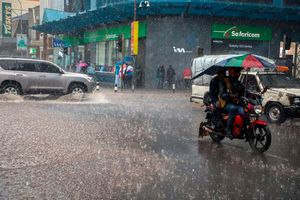Kenyans recall terrible effects of 1997 El Nino rains as they prepare for deluge

A file photo woman uses a stick to wade through flooded sections of her compound at Ombaka village in Kano, Kisumu County, on December 3, 2019.
One of the unhappy pages in the country’s history books is the impact of a 10-month rain season that hit Kenyans in 1997.
When the rains began in May that year, some people imagined they would subside in a matter of days or weeks, but they lasted until February 1998. The country’s meteorological department had announced an impending El Niño, which would result in above-average rainfall in the country.
The Kenya Meteorological Department describes it as a “very strong El Niño”, the effects of which are still etched in the minds of those who lived through it.
This year, the Met, World Meteorological Organisation (WMO) and Igad’s Climate Prediction & Applications Centre (ICPAC) have already predicted the El Niño.
Ms Eunice Koech, a climate scientist at ICPAC, told the Nation that rainfall in the region is linked to the oceans.
“The oceans are always warming and cooling, but at the moment they are warming. When the oceans warm, they tend to cause increased rainfall in our region. This is happening in the Indian and Pacific oceans,” she explained. This will lead to an El Niño. It is for this reason that in less than two weeks, Kenyans will experience above-average rainfall.
The Central region was one of the worst-hit areas in 1997, with people losing their lives and others losing livelihoods. The Nation visited some families in Nyeri County that were affected during this period.
We find Peter Muriithi on his farm, preparing his land. Situated in the vast, valley-like terrain of Mukurwe-ini Constituency, the green, forested area still bears the scars of the 1997 El Niño.
Peter was already a family man when it hit. As he moves around his farm, carrying a forked jembe, he vividly recalls the time.
“I remember a lot about the 1997 El Niño, especially its negative effects. Our crops in the farms were washed away, some people’s houses went with the water and all of this was caused by the landslides,” he says. “As someone who lived through it, the prediction of an impending El Niño is frightening, but what do we do? We are waiting for God and the government to help us.”
His neighbour, Sophia Njoki, says she is even more worried about her school-going children.
“What if we are displaced by the rains, where will I take my children? I remember how bad the rains were in 1997, it was so bad that some people’s graves were almost washed away,” she says.
Mr Edward Mururu, who lives not far from the Ragati River, says that some of his neighbours are not keen on planting this season.
“Most people who saw the effects of 1997 believe they will suffer losses if they plant this time,” he says. He recalls the scale of displacement caused by the rains, and even lifestyle changes.
“Most people in Nyeri had to change the way they covered their roofs after the El Niño rains. At that time, firewood was widely used as a source of energy. When the smoke rose to form soot, it affected the roofs and made them weak. When the rains came, most of the kitchen roofs collapsed and people had to find new ways of roofing,” he explains.

Peter Muriithi at his farm in Ichamaara village, Nyeri County on September 20. He said that the 1997 El Nino rains washed away the topsoil on his farm leaving a murram layer.
“I remember that people who lived near the river banks were in a kind of isolated land. The floodwaters made it look like there were two rivers bordering each other. Most of them had to stay indoors for days until the water receded,” he says.
In other parts of Mukurwe-Ini, farmers are digging gullies to help prevent landslides and soil erosion.
“We know that in 1997 most of our fertile land went into the river and we don’t want that to happen again. We are trying to cushion ourselves from any consequences, especially food insecurity,” says Mr Nelson Gachohi.
Some roads are already in disrepair because the gabions that were erected some time ago are in a terrible state. This poses an immediate risk when the rains come.
While the Met says the 2023 El Niño is likely to be close to what happened in 1997, they insist it cannot be the same. Assistant director Hannah Kimani, who is in charge of sub-seasonal and seasonal forecasting, explains that in 1997, the Ocean Nino Index, which is used to measure the strength of El Niño, was very high, at around 2.4.
“If you compare that to what we are currently observing, the models show that we are likely to see a moderate to strong El Niño, and the highest the models have predicted so far is about 2.0,” she explains. She adds that although this year’s index is lower than in 1997, people should still be concerned and take early action to mitigate the likely impacts.
While 1997 was one of the worst ever, Kenya also experienced El Niño-driven rains in 2006 and 2015, but Ms Kimani says that these two episodes were not as intense.
In July this year, WMO announced that El Niño conditions had begun to develop for the first time in seven years. They warned that it was setting the stage for a rise in global temperatures and unsettling weather and climate variability. July this year has already been declared the hottest month on record, breaking records dating back to 1850.
The WMO explains that an El Niño occurs on average every two to seven years, and its episodes last about nine to 12 months, adding that it takes place in the context of a climate altered by human activities.

Some of the youths employed by Nairobi County to take part in El Niño preparedness at Uhuru Park Nairobi on September 11, 2023.
“The WMO’s declaration of an El Niño is the signal for governments around the world to mobilise preparations to limit the impacts on our health, our ecosystems and our economies,” said WMO Secretary-General Petteri Taalas in a July update. “Early warning and anticipation of extreme weather events associated with this major climate phenomenon are essential to save lives and livelihoods.”
In a public notice, the Water Resources Authority (WRA) warned of the likelihood of dams overflowing and rivers rising, leading to flooding during El Niño.
They have mapped out some of the rivers in the country that are likely to rise and eventually cause flooding. They include lower Nyando, Nzoia, Sondu and Gucha in Migori and parts of the rivers along the shores of Lake Victoria. Others are lower Pekerra, Enkare Narok River in Rumuruti and lower Tana in Garissa, Hola and Garsen.
Some parts of the country such as Nairobi, Narok, Isiolo, Wajir and Mandera are expected to experience flash floods.
The authority also listed a number of dams that may fill and overflow. These are Bathi, Chemeron, Chemususu, Chinga, Ellegrini, Kakuzi, Gitaru, Kambuu, Kiambere, Kindaruma, Masinga, Kiboko and Kikoneni. Others are Kimau, Kirandich, Kiserian, Maruba, Mkurumduzi, Moiben, Mulima, Muoni, Radat, Ruiru, Sasumua, Sondu Miriu, Thiba, Thika, Ndakaini, Tindress and Turkwell.
WRA advised communities living downstream of the rivers and near the dams to be cautious and heed warnings from the authorities.
“They (communities) should identify and use safe routes to evacuate to higher and safer ground, approach river crossings with caution and beware of manholes,” the authority advised.
WRA also urged dam owners to take measures to protect downstream residents, infrastructure and the environment.
“They should ensure that spillways are properly maintained and free of obstructions to achieve full design spillway capacity. Have regular safety inspections of dams,” it said.
The El Niño is not just happening in Africa. An Anticipated Humanitarian Impact Report 2023 published by ACAPS in July this year shows that the El Niño will have severe impacts in Central America (dry conditions), northern South America (dry conditions), East Africa (both dry and wet conditions), and East Asia and the Pacific (dry conditions).
According to the Food and Agriculture Organization (FAO), El Niño affected more than 60 million people worldwide from 2015 to 2016, leading to humanitarian appeals of about $5 billion in 23 countries.
Its Anticipatory Action and Response Plan indicates that the world will need about $89 million to provide immediate assistance to the most vulnerable and affected populations in the second half of this year.
It suggests that governments take steps such as advising fishermen to shelter their boats before storms, strengthening river banks before floods, distributing drought-tolerant seeds to rain-fed farmers and protecting livestock health.
“They should also take advantage of El Niño’s positive spillover effects to offset losses, for example by providing seeds to flood-affected farmers so they can plant and reap when the floodwaters recede,” says FAO.
They are also urging governments to take early action where El Niño is causing devastation.
“This could be done by pre-positioning the most time-sensitive supplies, such as veterinary medicines, seeds and water bladders, while providing cash to severely affected families to meet their most immediate needs,” it further states.
ICPAC Director Guleid Artan warned that some parts of East Africa could see a locust invasion during this period.
“Desert locusts are already proliferating at alarming rates in parts of the region. The risk of deadly incidents also increases significantly. We all remember the last El Niño in 2015/16, when torrential rains caused landslides, flash floods and the collapse of buildings. Governments and disaster management agencies are advised to take all necessary measures to save lives and livelihoods,” he said.





